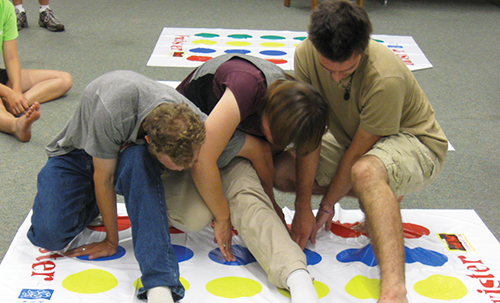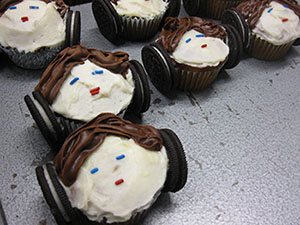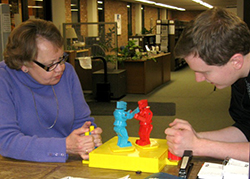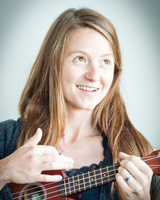
Academic libraries usually take their mission seriously, and at the University of Minnesota Morris’ (UMM) Rodney A. Briggs Library, we’re no different. We offer research assistance, quiet spaces for study, technology, instruction, rich scholarly resources, opportunities for collaboration, and of course, the opportunity for students to challenge our library director to a Rock ’Em Sock ’Em Robots battle.

Admittedly, that last event may not be a traditional academic library service. But at Briggs, we’ve supplemented those traditional services by staying open until late in the evening one Friday every month to offer students the chance to unwind at Game Night @ Briggs Library. During Game Night, students can set aside their papers and presentations and relax with friends over a good board game—with occasional appearances by Princess Leia cupcakes, zombies sitting at study tables, and knots of competitors on Twister mats.
Silliness with a purpose
It may all be fun and games, but there’s a deeper motive. We saw a need to provide a fun campus activity on Friday nights and the opportunity to engage with students and the wider campus in a new way. We hoped to attract patrons who don’t regularly venture through our doors, and make them feel at home in a place usually associated with homework and studying. We also wanted to give students the chance to see the library and its librarians in a different light.
Other academic libraries that have implemented game nights—such as Michener Library at the University of Northern Colorado—share this philosophy. “We wanted the event to be as casual and as welcoming as possible,” Instructional Services Librarian William Cuthbertson says, “so we tried not to over-manage the students. We set up tables with games around the library, provided clear signage, and put some of our friendliest faces on it.”
At the University of North Texas Media Library, Media Cataloger Diane Robson says she believes game nights have allowed the library to “reach out and meet new people on our campus.” That has resulted in strengthened relationships among students and staff. “Many of the dorm coordinators think of us when they need someone to help cohost an event,” Robson says.
Building a collection

Briggs is a small library, and we’ve had to come to terms with the knowledge that we can’t be everything to everyone. The UMM student center already has videogames that students can play on a large flatscreen TV, so we have focused our Game Night on tabletop games: board games (including Settlers of Catan, Risk, Clue, Quelf, Cranium, Dixit, and Monopoly) and card games (such as We Didn’t Playtest This at All, Dominion, Fluxx, Gloom, Apples to Apples, Munchkin, Magic: The Gathering, and the raunchy but popular Cards against Humanity). Videogames are also in the mix but are usually limited to multiplayer games like League of Legends, an online fantasy game, and Artemis, a starship simulation.
In tight budget times, libraries often don’t have money to purchase games. This is true at Briggs Library, where most of our games were donated by library staffers. In an ironic twist, some generous students lend us games for individual Game Nights. Each semester several librarians purchase new games to keep our offerings fresh. We listen to student requests and search online to make our selections, and over the years we’ve developed a sizable collection. We’ve chosen not to catalog that collection, so they are available only for in-library use on Game Night.
Naturally, different libraries build game events that fit their needs and the needs of their community. While focusing more on tabletop games than videogames was the right choice at Briggs, we’ve heard from plenty of colleagues at other institutions about the popularity of the videogame programs they’ve offered. For example, Pepperdine University librarians Marc Vinyard and Jaimie Beth Colvin tell us that Super Smash Bros. and Mario Kart tournaments they held in spring 2013 each drew strong participation.
Making it happen
Game Night is all about creating a fun atmosphere with good-natured library staff. We try to keep it simple. Students know how to have fun, so we just give them the tools and the space to make that happen.

Even so, Game Night means extra work, since it takes place after the library normally closes. We handle staffing for Game Night on an informal rotation system. Each of the five professional librarians on our staff works two or three Game Nights per semester, with two librarians on duty to help with games and to run the circulation desk. Librarians sign up for the nights that work best with their schedule. The egalitarian arrangement has worked well.
Some of our Game Nights have a special activity that extends beyond the usual gaming options. Past examples include game tournaments, zombie makeup sessions for students going to Zombie Prom, speed dating, scavenger hunts, indoor miniature golf, international games, a Halloween costume parade, and our annual faculty-versus-student Academic Trivia Contest. As an added bonus, all of the librarians offer Game Night activity ideas, so we can generally arrange the schedule so the person who proposed an activity is on hand to run it.
Some of our ventures are more successful than others, of course. Magic: The Gathering tournaments and zombie makeup sessions were big hits, but we had only one student shoot the links in the library for miniature golf, and no one was romantically inclined for a night of speed dating. Learning what we do best has been part of Briggs Library’s Game Night evolution.
While we’ve had the occasional off night, the event is usually very popular. Publicity is a big part of the reason why. We use many methods to get the word out: emails, posters, digital signage, social media, and announcements in the student newspaper, campus calendar, and on the student radio station. We also post pictures after each Game Night on the library’s Flickr page.
Collaboration has also been a valuable tool to help plan Game Night and raise awareness and attendance. Over the years we have worked with a variety of student organizations and campus units, including the International Student Association, the Magic: The Gathering Club, UMM Intramurals, and several residence halls and campus apartments. Collaborating with other groups doesn’t guarantee a successful Game Night, but it does often help increase participation. It can also make the whole operation more enjoyable and alleviate some of our library staffers’ workload.
Briggs Library has also looked beyond the campus for partners. One local comic and gaming store regularly donates prizes for tournaments and recently offered to cosponsor one Game Night every semester. The proprietor even sets up a game-testing table to introduce new games to students.
One final, but not surprising, contributor to success: free food. At each Game Night we offer a variety of highly non-nutritious snacks such as chips, cookies, and pop. We’ve learned from experience not to put them all out at once so they last throughout the evening.
Reach students early
The start of the semester is one of the best times to reach students and help them be comfortable in the library. At Briggs Library, we partner with the Office of Student Activities and the Office of Residential Life to host a Twister tournament during our Welcome Week Game Night. With boards donated by Mattel, this tournament is one of our most popular Game Night events, averaging 75–100 students for the contest itself, in addition to the students who show up to play other games.
Similarly, staff members at Michener Library pulled out all the stops for their inaugural game night in fall 2013, which coincided with the campus’s “Bear Welcome” week events. In addition to tabletop games and videogames, activities included a Clue-inspired librarywide quest that sent students in search of the Michener Miscreant, and a very special arts and crafts table.
“One of the surprise successes of the event for us was the Mustachery,” Cuthbertson says. “We had Andrea Falcome, head of instructional services, staff the mustache-crafting area and the camera. Some of the most enjoyable photos are of student couples and friends wearing their cardboard mustaches.”
Meanwhile, the University of Wisconsin–Eau Claire’s McIntyre Library hosts nearly 1,000 students during its Welcome Week game night, which includes oversized versions of Jenga and Connect Four, as well as videogames and board games.
Time and money are often the biggest obstacles to hosting Game Night. Is it worth it? The student feedback we get tells us that it is. The laughter that fills the main floor of the library is one of the sweetest sounds, and the value of creating a fun space for students is well worth the effort and expense.


